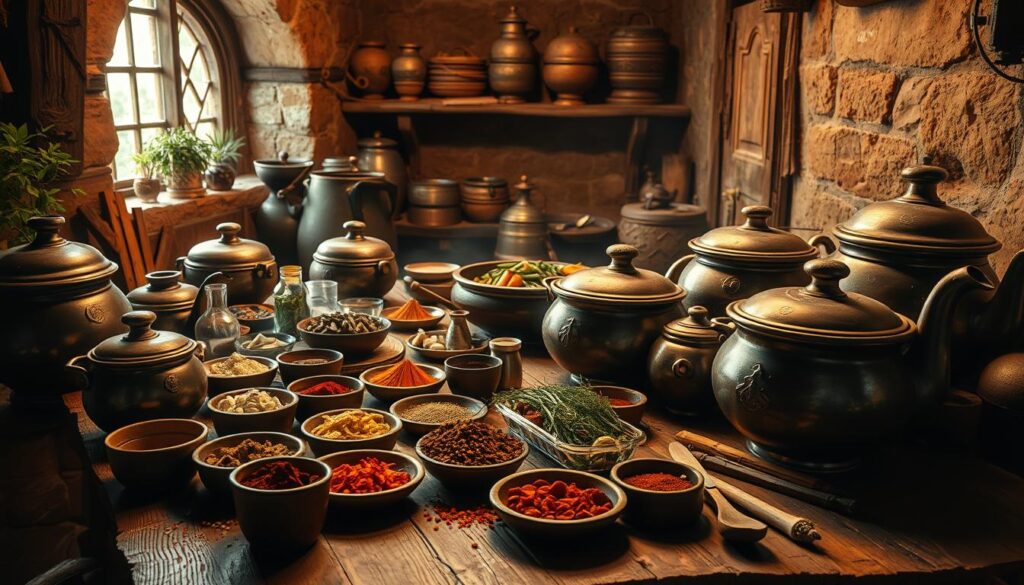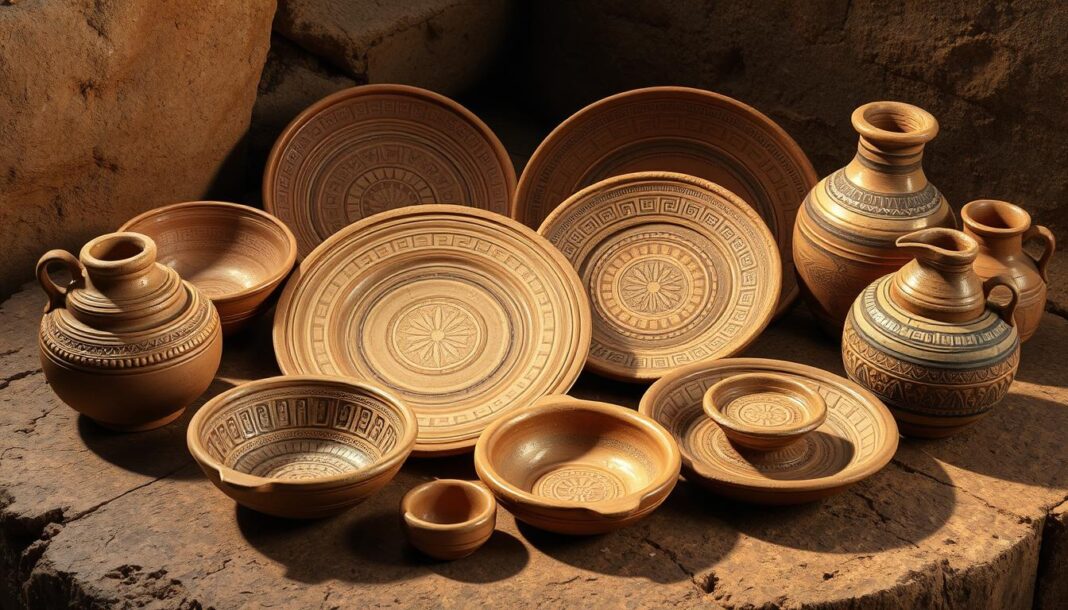We embark on a culinary journey through time, delving into the fascinating world of historical dishes that have shaped our gastronomic history. By exploring the ingredients, techniques, and cultural significance behind these culinary creations, we gain a deeper understanding of how food has evolved over the years.
Archaeological evidence and scholarly research have enabled the recreation of ancient recipes, allowing us to experience flavors from thousands of years ago. From Mesopotamia, home to the world’s oldest cookbook, to Ancient Rome and Greece, we’ll examine the dishes that reveal surprising connections to modern cuisine.
Key Takeaways
- Understanding the historical context of food preparation
- Exploring the cultural significance of ancient culinary practices
- Discovering how archaeological findings have aided in recipe recreation
- Examining the evolution of food across different civilizations
- Uncovering the surprising continuity in food culture across millennia
The Culinary Time Machine: Rediscovering Ancient Gastronomy
A team of international scholars has taken on the challenge of recreating dishes from the world’s oldest-known recipes. This endeavor is not just about cooking; it’s a journey through time that allows us to experience the flavors and culinary practices of our ancestors. By studying ancient culinary traditions, we gain insight into the history of food and its role in shaping cultures.

Archaeological Evidence of Early Cooking
Archaeological discoveries provide our primary window into ancient cooking practices. Preserved cooking vessels, food remains, and written recipes offer tangible connections to cuisines thousands of years old. For instance, Yale University’s Babylonian Collection contains tablets dating back to 1730 BCE, representing the world’s oldest known written ancient recipes. These artifacts are crucial in understanding Mesopotamian culinary traditions and the process of food preparation in ancient times.
The evidence from various archaeological sites reveals how cooking techniques evolved over time, from simple roasting over open fires to more sophisticated methods involving specialized cookware and controlled heat sources. This evolution is a testament to human ingenuity and the continuous quest for better culinary practices.
How Scholars Recreate Ancient Food Recipes
Recreating ancient recipes is a complex task that requires interdisciplinary expertise. Scholars must combine knowledge of ancient languages, food chemistry, and culinary history to interpret the sparse instructions found on ancient tablets. The process involves deciphering ingredients, understanding cooking techniques, and making educated guesses about quantities and methods.
By recreating these dishes, scholars not only bring ancient culinary practices to life but also provide a sensory connection to history. This connection helps us understand daily life in past civilizations in ways that artifacts alone cannot convey, making the study of ancient food a rich and rewarding field.
Ancient Mesopotamian Food Recipes: The World’s Oldest Cookbook
Delving into the ancient world of Mesopotamia, we uncover the secrets of the world’s oldest known cookbook, etched on clay tablets around 1750 BCE. These ancient recipes offer a fascinating glimpse into the culinary practices of a civilization that thrived in the region now known as Iraq, Syria, and parts of Turkey.
The clay tablets contain a variety of dishes, showcasing the sophisticated cuisine of the Mesopotamians. Let’s explore a few of these ancient food preparations, starting with a lamb stew known as Me-e Puhadi.
Lamb Stew (Me-e Puhadi): The 4,000-Year-Old Recipe
This ancient recipe for lamb stew combines meat with barley cakes, onions, shallots, leeks, and garlic, creating a complex dish that remains relevant in Middle Eastern cooking today. The instructions read like a list of ingredients: “Meat is used. You prepare water. You add fine-grained salt, dried bread (barley cakes), onion, Persian shallot, and milk. You crush and add leek and garlic.”
Tuh’u: Ancient Beetroot Stew
Another fascinating recipe is Tuh’u, an ancient beetroot stew that showcases the Mesopotamians’ use of vegetables. This hearty dish includes diced mutton, beetroot, rocket, coriander, and various aromatics, creating a visually striking red-colored stew.
Mesopotamian Beer: The Oldest Fermented Beverage
Beer was a staple in ancient Mesopotamia, produced by fermenting a bread-like substance called bappir in water. The resulting beer was described as nutty with a hint of sweetness, a beverage that not only provided nutrition but also safe hydration.
These ancient Mesopotamian recipes reveal a sophisticated cuisine that balanced available ingredients with preservation techniques, creating flavorful food that sustained one of the world’s earliest civilizations.
Ancient Roman Food Recipes That Shaped Culinary History
Exploring Ancient Roman recipes reveals the sophistication of their culinary traditions. The Roman Empire’s vast territories and trade networks brought diverse ingredients and cooking techniques to their kitchens, shaping a cuisine that was both complex and refined.
Ancient Roman cuisine is well-documented thanks to texts like Apicius’ “De Re Coquinaria,” which contains hundreds of recipes that influenced Western food culture for centuries. These recipes demonstrate a blend of traditional ingredients and innovative cooking methods.
Libum: Roman Cheesecake with Honey and Poppy Seeds
Libum, a simple yet delicious cheesecake, was sweetened with honey and sprinkled with poppy seeds. Originally created as an offering to household gods, it evolved into a popular everyday treat that showcases the Romans’ skillful use of fresh cheese and natural sweeteners.
Patina de Apua: The Black Egg Dish with Cuttlefish Ink
The striking Patina de Apua exemplifies Roman culinary experimentation, combining eggs with cuttlefish ink to create a dramatic black dish. This recipe would have been a conversation piece at elite Roman dinner parties, though its appeal was more visual than flavorful.
Dates Stuffed with Nuts: Roman Sweet Treats
Roman sweet treats like dates stuffed with nuts, seasoned with exotic long pepper, and cooked in honey reveal the empire’s vast trade networks. These ingredients, sourced from across the world, were brought to Roman tables, showcasing their culinary creativity.
Moretum: The Ancient Roman Garlic-Herb Spread
Moretum, a versatile garlic-herb spread featuring cheese and various aromatics, served as an ancient precursor to modern pesto. It was commonly spread on bread as a flavorful accompaniment to meals, demonstrating the Romans’ appreciation for fresh flavors.
These Roman recipes demonstrate sophisticated culinary techniques, including precise temperature control, complex flavor combinations, and an appreciation for visual presentation. Many elements of Roman cuisine continue to influence Mediterranean cooking today, with dishes like moretum evolving into regional specialties.
- The Roman approach to food combined practical preservation methods with artistic presentation.
- Their culinary tradition balanced necessity with pleasure, defining Western cooking for centuries.
- Roman cuisine’s legacy can be seen in the many dishes and flavors that have been passed down through the ages.
Ancient Greek Culinary Traditions and Recipes
The flavors and dishes of Ancient Greece remain relevant in today’s culinary world. Ancient Greek cuisine formed the foundation of Mediterranean food culture, emphasizing simple preparation methods that highlighted the natural flavors of fresh, seasonal ingredients available throughout the region.
Pasteli: The Original Energy Bar of Ancient Greece
Pasteli, a concentrated mixture of honey and sesame seeds, served as the original energy bar for ancient Greeks. This simple yet nourishing dish provided sustained energy for athletes, travelers, and soldiers with its perfect balance of natural sugars and protein, making it an integral part of life in Ancient Greece.
Olympian Athlete’s Meal: Grilled Meat with Herbs
The diet of Olympic athletes reveals much about Greek nutritional understanding. Their meals featured carefully balanced grilled meat seasoned with herbs, accompanied by barley bread and wine diluted with water—a regimen designed for optimal athletic performance. This cooking technique prioritized the enhancement of natural flavors rather than masking them.
Nut and Honey Sauce for Poultry
The sophisticated nut and honey sauce for poultry demonstrates the Greeks’ talent for creating complex flavor profiles. By combining hazelnuts or almonds with honey and herbs, they created a savory-sweet accompaniment that would not be out of place in modern gourmet cooking. This sauce is a testament to the advanced culinary techniques of Ancient Greece.
These recipes not only showcase the culinary expertise of Ancient Greece but also highlight the culture‘s emphasis on fresh ingredients and simple preparation methods. Today, we continue to draw inspiration from these ancient dishes, incorporating them into our modern culinary practices.
Techniques and Ingredients in Ancient Food Recipes

Exploring ancient food recipes offers a window into the past, showcasing the resourcefulness and creativity of our ancestors in the kitchen. Ancient civilizations developed sophisticated culinary techniques and used a variety of ingredients that not only flavored their food but also played crucial roles in preservation and nutrition.
Preservation Methods in Ancient Times
Ancient civilizations developed various preservation methods out of necessity. Techniques like drying, smoking, salting, fermentation, and honey preservation allowed foods to remain edible for extended periods without refrigeration. For instance, fermentation was crucial in transforming grains into beer, milk into cheese, and cabbage into preserved vegetables, enhancing both nutritional value and flavor.
Common Spices and Flavorings Across Ancient Civilizations
The spice trade connected ancient civilizations, with ingredients like pepper, cinnamon, and saffron traveling thousands of miles. These spices not only added flavor to dishes but also served as status symbols and played significant roles in cultural and religious practices. The use of aromatic ingredients like garlic, onions, and herbs served dual purposes—enhancing flavor while providing antimicrobial properties.
The Role of Honey as the Universal Sweetener
Honey functioned as the universal sweetener across ancient civilizations, valued for its sweetness, preservative properties, medicinal uses, and religious significance. From Egypt to Greece, honey was a staple ingredient in cooking and medicine, used to sweeten dishes and preserve foods. Its importance is reflected in its continued use in various culinary traditions today.
Ancient Recipes in Modern Kitchens: Bringing History to Your Table
Ancient recipes offer more than just a taste of the past; they provide a connection to our culinary heritage. By bringing these historical foods to our modern tables, we not only honor the traditions of our ancestors but also gain a deeper understanding of how food continues to evolve while maintaining its roots in history.
The continuity between ancient and modern cuisine is remarkably evident in staple foods like bread and stew, which have remained fundamental across thousands of years. For instance, the Mesopotamian dish, Me-e Puhadi (lamb stew), is meant to be eaten with barley cakes crumbled into the liquid, much like we use bread to sop up a soup today. Similarly, Tuh’u, an ancient beetroot stew, shares striking similarities with both Eastern European borscht and Middle Eastern sweet-and-sour beetroot dishes still enjoyed today.
Recreating ancient recipes provides a tangible connection to history, engaging our senses and offering a literal taste of daily life in ancient civilizations. This culinary journey reveals that sophisticated cuisine isn’t a modern invention—ancient cooks had already developed complex techniques and flavor combinations that would be recognized and appreciated by today’s chefs. For more historical food recipes, visit our collection at https://historicalfoods.com/historical-food-recipes/.
The study of ancient recipes also highlights the endurance of certain flavor combinations throughout history, suggesting that human taste preferences have remained relatively consistent across time and cultures. By adapting these ancient recipes for modern kitchens, we can appreciate the wisdom of traditional food combinations, now validated by modern nutritional science for their complementary nutritional profiles and health benefits.
In conclusion, cooking ancient recipes is more than a culinary exercise; it’s an educational opportunity that makes history tangible for food enthusiasts. It demonstrates how culinary traditions reflect broader aspects of culture, trade, and technology, connecting us with our rich culinary heritage.


